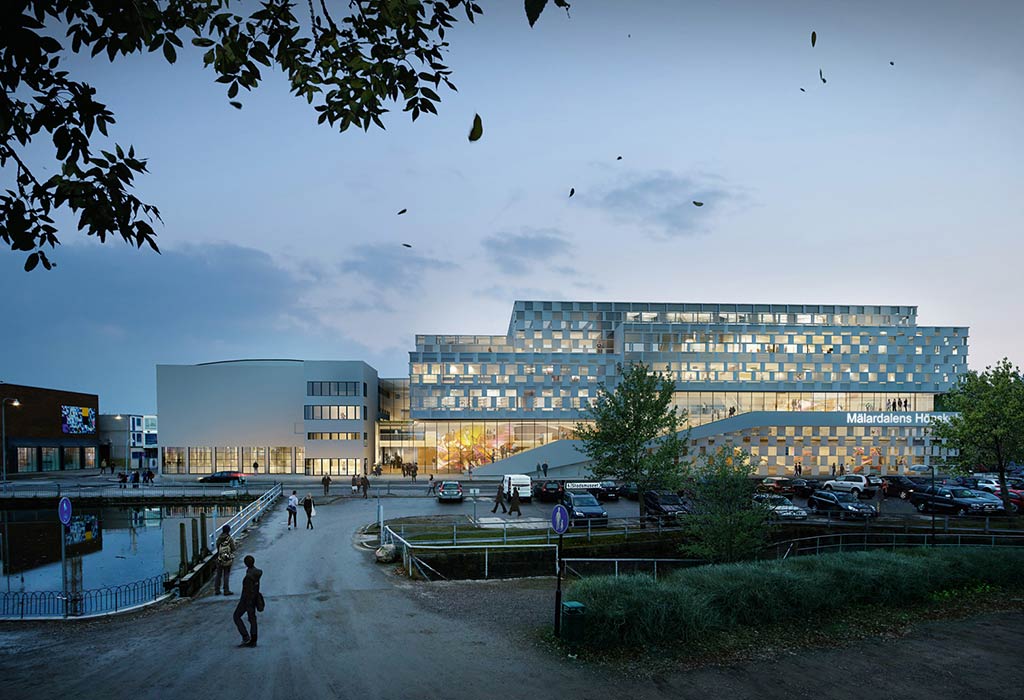Denmark-based architecture firm 3XN's design won the architectural competition for Mälardalen University's new educational facility in Eskilstuna, southwest of Stockholm, Architecturelab reports.
The new building's cubic shape, geometric trellis, and bright façade is a nod to the nearby historical, modernist public bathhouse designed by Paul Hedqvist in the 1930s.
The winning proposal is of a 196,441-sf structure that will house educational facilities and workplaces for 4,000 students and 350 students. The project is estimated to cost €49 million.
The firm said about the conversion:
"Internally, the new building connects to the public bath on the first to decks, creating a cohesive flow between old and new. The lower levels will be completely open and connected so that the new and old building seen as one functional and spatial whole. The volume of the main swimming pool is retained as the school library. By also locating the café and student house in the public bath, it becomes a unique social meeting place for the students.
"A central atrium, double-height auditoriums, open study areas and inner courtyards create a building with good visual connections between floors. Classrooms and lecture halls are located on the lower three floors. The administrative offices are at the top of the building, creating a more private working environment."
Related Stories
Legislation | Aug 5, 2022
D.C. City Council moves to require net-zero construction by 2026
The Washington, D.C. City Council unanimously passed legislation that would require all new buildings and substantial renovations in D.C. to be net-zero construction by 2026.
Cultural Facilities | Aug 5, 2022
A time and a place: Telling American stories through architecture
As the United States enters the year 2026, it will commence celebrating a cycle of Sestercentennials, or 250th anniversaries, of historic and cultural events across the land.
Sponsored | | Aug 4, 2022
Brighter vistas: Next-gen tools drive sustainability toward net zero line
New technologies, innovations, and tools are opening doors for building teams interested in better and more socially responsible design.
| Aug 4, 2022
Newer materials for green, resilient building complicate insurance underwriting
Insurers can’t look to years of testing on emerging technology to assess risk.
Sustainability | Aug 4, 2022
To reduce disease and fight climate change, design buildings that breathe
Healthy air quality in buildings improves cognitive function and combats the spread of disease, but its implications for carbon reduction are perhaps the most important benefit.
Multifamily Housing | Aug 4, 2022
Faculty housing: A powerful recruitment tool for universities
Recruitment is a growing issue for employers located in areas with a diminishing inventory of affordable housing.
Multifamily Housing | Aug 3, 2022
7 tips for designing fitness studios in multifamily housing developments
Cortland’s Karl Smith, aka “Dr Fitness,” offers advice on how to design and operate new and renovated gyms in apartment communities.
Building Materials | Aug 3, 2022
Shawmut CEO Les Hiscoe on coping with a shaky supply chain in construction
BD+C's John Caulfield interviews Les Hiscoe, CEO of Shawmut Design and Construction, about how his firm keeps projects on schedule and budget in the face of shortages, delays, and price volatility.
Codes and Standards | Aug 3, 2022
Some climate models underestimate risk of future floods
Commonly used climate models may be significantly underestimating the risk of floods this century, according to a new study by Yale researchers.
| Aug 3, 2022
Designing learning environments to support the future of equitable health care
While the shortage of rural health care practitioners was a concern before the COVID-19 pandemic, the public health crisis has highlighted the importance of health equity in the United States and the desperate need for practitioners help meet the needs of patients in vulnerable rural communities.























